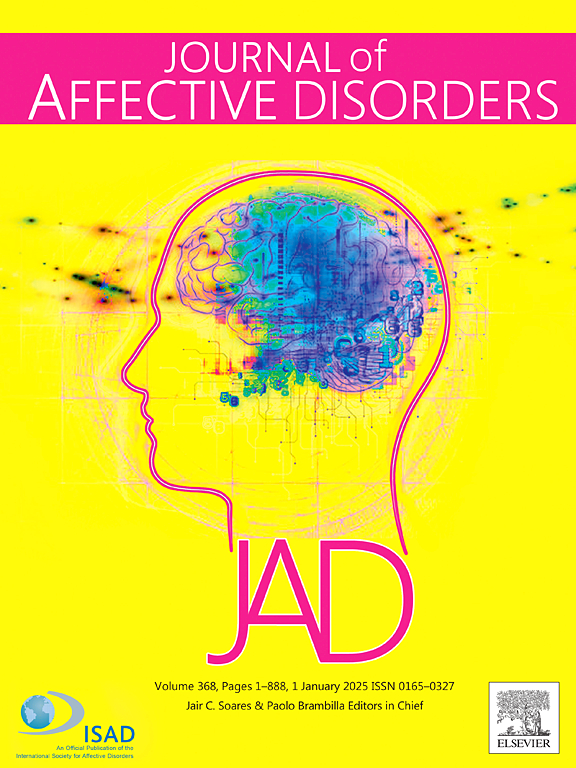Investigating causal relationships between gene expression and major depressive disorder via brain bulk-tissue and cell type-specific eQTL: A Mendelian randomization and Bayesian colocalization study
IF 4.9
2区 医学
Q1 CLINICAL NEUROLOGY
引用次数: 0
Abstract
Background
Major depressive disorder (MDD) is a highly prevalent psychiatric disorder with complex genetic underpinnings. While genome-wide association studies (GWAS) have identified multiple risk loci, pinpointing causal genes within the human brain remains challenging, particularly given the regulatory complexity across different cell types.
Methods
We performed summary data-based MR (SMR) and Bayesian colocalization analyses by integrating bulk-tissue eQTL data from 888 individuals with single-cell eQTL datasets from 192 donors representing major brain cell types (excitatory and inhibitory neurons, astrocytes, microglia, oligodendrocytes, OPCs/COPs, endothelial cells, and pericytes). GWAS summary statistics for MDD (170,756 cases and 329,443 controls) were used to assess the causal impact of gene expression. Sensitivity analyses, including the heterogeneity in dependent instruments (HEIDI) test and Steiger filtering, ensured robust inference.
Results
In bulk tissue analyses, five genes (BTN3A2, SLC12A5, AREL1, GMPPB, and ZNF660) emerged as having robust causal evidence for MDD, displaying consistent MR signals and strong colocalization. Cell type-specific analyses revealed additional candidate genes in excitatory neurons (FLOT1, AL450423.1), astrocytes (AL121821.1), and oligodendrocytes (YLPM1, COP1).
Conclusion
Our integrative approach reveals that causal gene expression profiles differ markedly between bulk-tissue and specific brain cell types, emphasizing cellular heterogeneity in MDD pathogenesis and informing precision therapeutic strategies. These findings underscore the necessity of considering cell type-specific gene regulation when developing therapeutic interventions for MDD.
通过脑组织和细胞类型特异性eQTL研究基因表达与重度抑郁症之间的因果关系:孟德尔随机化和贝叶斯共定位研究
重度抑郁症(MDD)是一种高度流行的精神疾病,具有复杂的遗传基础。虽然全基因组关联研究(GWAS)已经确定了多个风险位点,但在人类大脑中精确定位致病基因仍然具有挑战性,特别是考虑到不同细胞类型的调控复杂性。方法通过整合来自888名个体的大组织eQTL数据和来自192名主要脑细胞类型(兴奋性和抑制神经元、星形胶质细胞、小胶质细胞、少突胶质细胞、OPCs/COPs、内皮细胞和周细胞)的单细胞eQTL数据集,我们进行了基于数据的MR (SMR)和贝叶斯共定位分析。GWAS的MDD汇总统计数据(170,756例和329,443例对照)用于评估基因表达的因果影响。敏感性分析,包括依赖工具异质性(HEIDI)检验和Steiger滤波,确保了鲁棒性推断。结果在大量组织分析中,5个基因(BTN3A2、SLC12A5、are1、GMPPB和ZNF660)出现了强有力的MDD因果证据,显示出一致的MR信号和强共定位。细胞类型特异性分析揭示了兴奋性神经元(FLOT1, AL450423.1),星形胶质细胞(AL121821.1)和少突胶质细胞(YLPM1, COP1)中的其他候选基因。结论我们的综合方法揭示了大块组织和特定脑细胞类型之间的因果基因表达谱存在显著差异,强调了MDD发病机制的细胞异质性,并为精确的治疗策略提供了信息。这些发现强调了在开发MDD治疗干预措施时考虑细胞类型特异性基因调控的必要性。
本文章由计算机程序翻译,如有差异,请以英文原文为准。
求助全文
约1分钟内获得全文
求助全文
来源期刊

Journal of affective disorders
医学-精神病学
CiteScore
10.90
自引率
6.10%
发文量
1319
审稿时长
9.3 weeks
期刊介绍:
The Journal of Affective Disorders publishes papers concerned with affective disorders in the widest sense: depression, mania, mood spectrum, emotions and personality, anxiety and stress. It is interdisciplinary and aims to bring together different approaches for a diverse readership. Top quality papers will be accepted dealing with any aspect of affective disorders, including neuroimaging, cognitive neurosciences, genetics, molecular biology, experimental and clinical neurosciences, pharmacology, neuroimmunoendocrinology, intervention and treatment trials.
 求助内容:
求助内容: 应助结果提醒方式:
应助结果提醒方式:


